Saturday, April 16, 2005
Silvered Æ antoninianus, Gallienus, Antioch, Göbl 1651b
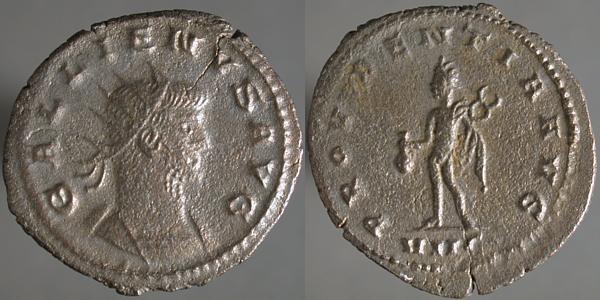
GALLIENVS AVG, Radiate cuirassed bust right | PROVIDENTIA AVG, Mercury standing facing, head left, holding caduceus right and purse left. VIIC· in exergue.
Göbl does not attest this bust for this reverse, but he certainly attests the reverse, and the bust for many contemporary issues from this mint. There's a place for it in the attribution grid, and without going hunting in obscure catalogs, this is a coin that's expected, but not elsewhere recorded.
To imagine that it's really unknown, or unique, would be to ignore how little attention is paid to the pedestrian, even ugly, coins of this reign.
Friday, April 15, 2005
Æ31, Ephesus in Ionia, Valerian, BMC 369 var ...
(reverse legend)
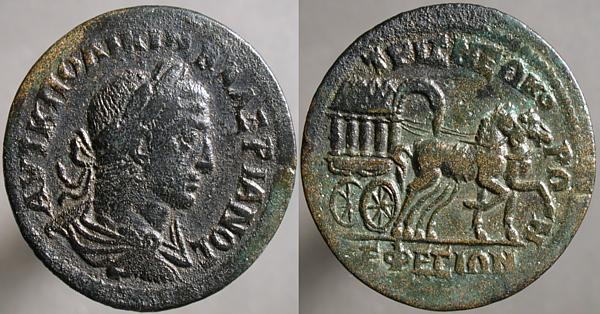
AVT K ΠO ΛIKIN BAΛEPIANOC, Laureate draped cuirassed bust right | TRIC NEΩKO_PΩ_N, Carpentum drawn by two mules right, EΦECIΩN in exergue.
The animals drawing the carpentum here are stated to be mules, i think, because mules were commonly used for this, rather than because these look identifiably different from horses. A mule advocate speaks.
The reverse legend here, a bit different than that in the catalogs I have, notes that Ephesus is thrice Neokorate (it has three temples of the imperial cult), a fact not mentioned on any other Ephesian coin I own.
Information relating the carpentum to Irish war chariots here, and information on Roman wheeled vehicles here.

AVT K ΠO ΛIKIN BAΛEPIANOC, Laureate draped cuirassed bust right | TRIC NEΩKO_PΩ_N, Carpentum drawn by two mules right, EΦECIΩN in exergue.
The animals drawing the carpentum here are stated to be mules, i think, because mules were commonly used for this, rather than because these look identifiably different from horses. A mule advocate speaks.
The reverse legend here, a bit different than that in the catalogs I have, notes that Ephesus is thrice Neokorate (it has three temples of the imperial cult), a fact not mentioned on any other Ephesian coin I own.
Information relating the carpentum to Irish war chariots here, and information on Roman wheeled vehicles here.
Thursday, April 14, 2005
Æ antoninianus, Gallienus, Rome, Göbl 712bvar
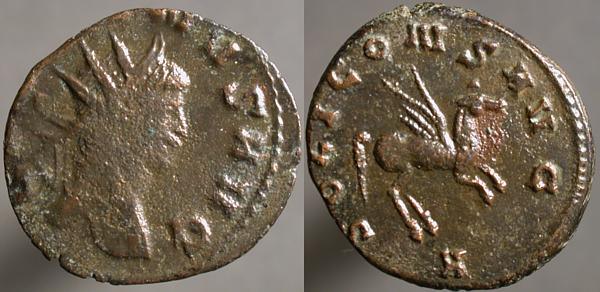
GALLIENVS AVG, Radiate head right | SOLI CONS AVG, Winged horse leaping right. A in exergue, no ground line.
Fascination with, and concentration on, minutiae characterizes the collector as perhaps nothing else does. This coin is special because the horse appears to fly in space, since the line of the ground, as seen on this example, has been omitted.
Wednesday, April 13, 2005
AR antoninianus, Pupienus, Rome, 238 CE, RIC 11b
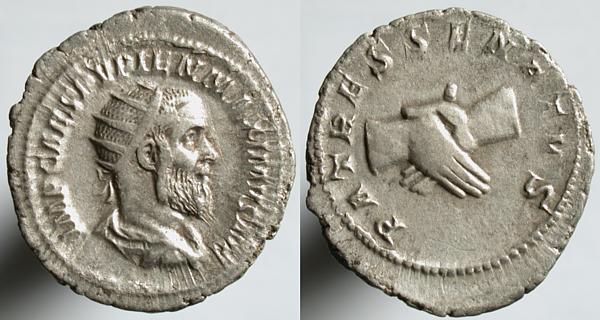
IMP CAES PVPIEN MAXIMVS AVG, Radiate draped bust right | PATRES SENATVS, Clasped hands.
As with Balbinus, so with his co-emperor, Marcus Clodius Pupienus Maximus. The reverse here illustrates concord with the conscript fathers of the Senate, who had little concord with him, in fact.
Tuesday, April 12, 2005
Æ31, Tarsus in Cilicia, Valerian, SNG Copenhagen 406
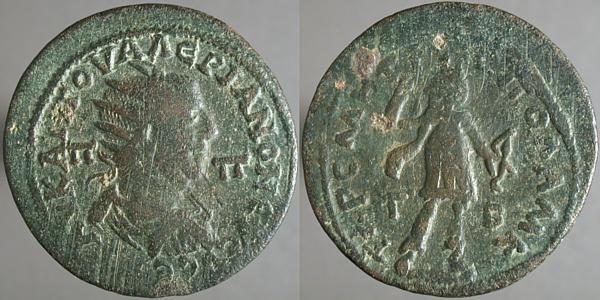
AV KAI Π OVAΛEPIANON EV EV CE, Radiate draped cuirassed bust right, Π before and behind | TAPC MHTP_OΠOΛ A M K, Artemis, wearing stag horns, standing right, holding bow right, drawing arrow from quiver on shoulder. Γ in left field, B in right.
Chaste Artemis was a favorite at Tarsus. I have a few examples, all showing her in such a similar pose that I suspect a statue, familiar to the inhabitants, was being shown.
Monday, April 11, 2005
Silvered Æ antoninianus, Gallienus, Rome, Göbl 549nvar
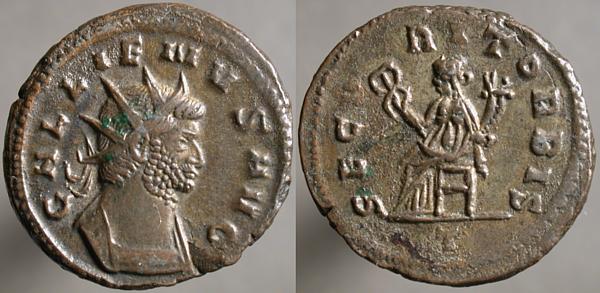
GALLIENVS AVG, Radiate cuirassed bust right | SECVRIT ORBIS, Felicitas seated left, holding overflowing cornucopia right and caduceus left. T in exergue.
About a year ago I posted a similar coin and pointed to a brief thread on the FORVM discussion boards about it.
I recently acquired this example, with a cuirassed bust, from a different reverse die, but sharing the odd mismatch between legend and figure, unremarked by Göbl when he used a photograph of this coin.
This coin, a little more investigation shows, was auctioned in Milan in 1957 as part of the Mazzini collection.
That there are two dies with the same error suggests to me something other than mistakes of carelessness. I speculate that two (or more) Felicitas dies were finished by the engraver responsible for the figure, but that the engraver responsible for the legend didn't get to them until the FELICIT PVBL issue was declared complete and the SECVRIT ORBIS issue begun. Whether by order or inspiration, someone decided it was better to use them, incorrect figure and all, than to discard them and begin again.
It is just speculation, and can't be proven or disproven, but I think it's a fascinating glimpse into the little-documented day-to-day operation of a Roman mint, some 1,750 years ago.
Sunday, April 10, 2005
Æ tetradrachm, Alexandria in Egypt, Salonina, Emmett 3864(14)

KOPNHΛIA CAΛωNEINA CEB, Diademed draped bust right | LIΔ, Tyche standing facing, head left, holding rudder left and cornucopia right. Palm in right field, regnal year in left field.
First, a whine about transcribing ancient Greek legends for HTML. A modern upper case Omega is Ω and lower case is ω. At the time this coin was minted, in Alexandria (and some other cities), fashion dictated an upper case Omega shaped like a larger ω. I know of no practical way to form such a letter in HTML, and no better dodge than to use the lower-case letter, ugly as that works out.
Second, a palm on the reverse of Alexandrian coins of this reign commemorated his decennalia, his tenth anniversary as Augustus. I imagine that a palm in the exergue of the Imperial coins minted at Antioch had the same significance.

